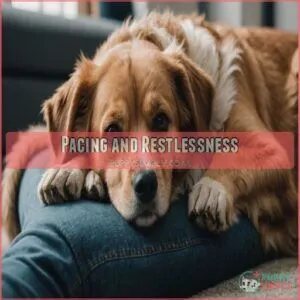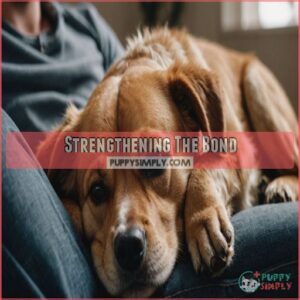This site is supported by our readers. We may earn a commission, at no cost to you, if you purchase through links.

It’s also a sign of trust and affection; they feel safe nestled close to you. Puppies especially love this closeness, feeling protected within the "pack."
But sometimes, it can become a bit much! Want to learn how to gently encourage independence while keeping that special bond strong? There are simple solutions to help you both sleep soundly.
Table Of Contents
- Key Takeaways
- Reasons for Sleeping Between Legs
- Addressing Concerns and Tips
- Why Dogs Prefer Sleeping Between Legs
- Signs of Separation Anxiety
- How to Discourage Sleeping Between Legs
- Factors Influencing Sleeping Behavior
- Strengthening The Bond
- Frequently Asked Questions (FAQs)
- Why does my dog sleep between my legs?
- Do dogs like to sleep between their owners’ legs?
- Why does my dog want to sleep next to me?
- Why does my dog curl up between my legs?
- What does it mean when a dog sleeps between your legs?
- Do dogs sleep with their favorite person?
- What does it mean when a dog sits between your legs?
- Why does my dog sleep in the middle of me and my partner?
- What breeds are most likely to do this?
- Can this behavior indicate health issues?
- How can I encourage my dog to cuddle?
- Does sleeping position relate to age or size?
- Is this behavior common in multiple dog households?
- Conclusion
Key Takeaways
- Your dog sleeps between your legs for warmth, comfort, and security, enjoying a cozy spot that resembles a den.
- This behavior strengthens your bond, as dogs love companionship and closeness with their "pack."
- Small breeds and puppies are especially drawn to this snug position for warmth and security.
- Encouraging independence with alternative sleeping arrangements can balance closeness and personal space.
Reasons for Sleeping Between Legs
Ever wonder why your furry friend insists on sleeping nestled between your legs?
It’s likely a combination of seeking warmth, feeling safe and secure, and enjoying your close companionship – basically, they’re saying, "I love you, human!
Comfort and Security
Snuggled between your legs, your dog finds comfort and security, much like a pup nestled with its littermates.
This cozy spot acts like a mini-den, easing dog anxiety and fears of the dark.
Trust and bonding grow, creating a special closeness.
So, when your dog curls up there, it’s their way of feeling safe and loved.
Warmth and Physical Contact
Feeling secure under your legs, your dog finds comfort and warmth, similar to the soothing feeling provided by a cozy warm blanket.
Dogs love the cozy heat, especially during chilly nights.
Their higher body temperature means they relish the physical contact that helps regulate heat.
This cuddling behavior is common in small breeds or short-coated dogs seeking warmth and trust, providing a snug haven.
Companionship and Affection
Imagine the warmth of a cozy blanket; that’s the feeling your dog gets from sleeping between your legs.
It’s all about companionship and affection, forming strong emotional bonds with you.
This cuddle time strengthens the human-dog connection, reflecting a love that’s built on trust and attachment.
Your dog sees you as their favorite pack member, basking in this shared closeness.
Protection and Dominance
Your dog isn’t just snuggling for warmth and affection; there’s more at play.
By sleeping between your legs, they’re keeping an eye out for potential threats, showcasing their guarding instincts and alpha dog role.
This territorial behavior ties back to pack hierarchy and protection.
They trust you, and this position boosts their sense of security and dominance in the pack.
Addressing Concerns and Tips
If your dog insists on sleeping between your legs, don’t worry—there are ways to address potential concerns while keeping your furry friend comfortable.
From providing a cozy bed to managing anxiety, these tips can make bedtime peaceful for both of you.
Providing a Dedicated Bed
Every dog deserves a cozy spot of their own. By offering a dedicated bed, you’re setting the stage for better dog sleeping habits, as dogs often prefer denning spaces for security. This supports dog comfort and security.
- Choose the right bed type for your dog’s needs.
- Consider strategic bed placement away from stressors.
- Make sure bed comfort with soft padding.
- Match bed size to your dog’s.
- Help your dog get used to the bed with familiar scents.
Ensuring Warmth and Comfort
So, you’ve given Fido a comfy bed, but he still prefers your legs?
He might just be a heat-seeker!
Dogs love warmth; their body temperature is higher than ours.
Try a cozy spot with extra blankets.
A heated pet bed might be a winner.
Remember, a warm pup is a happy pup!
This helps mimic the warmth and comfort he gets snuggled next to you.
Managing Stress and Anxiety
Imagine a scene where your furry friend seeks refuge between your legs to escape anxiety triggers.
Help them relax by introducing stress reduction techniques.
Try soothing calming scents or playing gentle calming music.
Trust-building exercises and calming exercises can also ease separation anxiety.
A calmer environment reduces stress, ensuring your pet feels safe and secure by your side.
Establishing Boundaries
While managing stress and anxiety helps, establishing boundaries helps your dog respect personal space.
Start early by offering a cozy heated bed designed to keep your pup warm in cold weather, or safe space.
Crate training and independent play build confidence.
Use positive reinforcement when your pup stays in their comfort zones.
This way, you both enjoy affection without your furry friend constantly sleeping between your legs.
Why Dogs Prefer Sleeping Between Legs
When your dog curls up between your legs, they’re not just trying to get warm; they’re seeking comfort and security, much like being part of a pack.
This cozy spot offers them a safe haven and reassures them with your presence, helping strengthen your bond.
Instinctual Behavior
Your dog’s instinctual behavior is like tapping into their inner wolf.
Nestled between your legs, they channel survival instincts, pack behavior, and denning instincts.
This spot mirrors a cozy den, fulfilling their instinctual need for social bonding.
This space reinforces their pack instinct, creating an intimate connection—the essence of dog love and dog bonding, all while indulging their innate territoriality.
Sense of Safety and Security
When your dog snuggles between your legs, it’s not just sweet; it’s about feeling safe.
This behavior is all about that comforting sense of security they crave.
By investing in a comfortable Dog Bed Options, you can also create a cozy space for them to unwind.
Here’s why:
- Safe Spaces: Dogs seek enclosed spaces, like the den, for comfort.
- Trust and Love: They trust you completely.
- Reassurance: This closeness eases their stress and fear.
Physical Contact and Closeness
Dogs love snuggling habits that bring them close to their favorite person.
Sleeping between your legs allows for physical touch and deepens the bond with affectionate dogs.
This cozy nook offers warmth and comfort, while a dog’s scent and close contact enhance the bonding experience.
Such positions reflect dog warmth and comfort, building owner-dog closeness through shared oxytocin moments.
Pack Instinct and Dominance
It’s not just about cuddles; your dog’s sleeping spot reveals a lot about pack dynamics.
Think of it like this: between your legs is a prime location, offering both warmth and protection.
This reflects their pack instinct, a deep-seated need for security and closeness.
It’s not necessarily about dominance; it’s about feeling safe and secure within their "pack."
They’re showing their love and trust, not trying to control you.
It’s a sweet, natural behavior!
Signs of Separation Anxiety
If your dog is stuck to you like glue, even cozying up between your legs, it might be trying to tell you it’s feeling a bit anxious when you’re away.
Separation anxiety can cause these snug habits.
Signs like extra clinginess, chewing up things they shouldn’t, or constant barking can indicate separation anxiety is causing these snug habits.
Increased Clinginess
Some dogs stick to you like glue, and that’s not just because they’re being cute.
Increased clinginess can signal separation anxiety, especially after recent changes or in a new environment.
This hyper attachment might stem from fears like sudden noises.
Recognizing dog emotional support needs can help ease their anxiety.
- Recognize sudden clinginess
- Address recent changes
- Observe fears
- Offer comfort
Destructive Behavior
You might notice your pup getting extra clingy, but chewing up your favorite shoes? That’s a classic sign of separation anxiety.
Your dog’s destructive behavior isn’t just boredom or stress; it could mean they’re seeking comfort when you’re away.
To tackle this, make sure they get enough exercise and mental stimulation, and think about changing their sleeping arrangements.
Excessive Barking
Excessive barking, ever a noisy mystery, often signals separation anxiety in dogs.
You might wonder why Rover’s yapping the moment you step out.
Here’s a handy guide:
- Barking triggers like changes in routine spark anxiety.
- Barking patterns reveal emotions and feelings.
- Barking solutions involve affection, understanding dog psychology, and adjusting behavior to provide comfort.
Keep peace and quiet with these insights.
Pacing and Restlessness
When Fido’s barking subsides, another sign of separation anxiety might appear: pacing and restlessness.
It’s like they’re practicing for a marathon around your living room.
These behaviors often signal anxiety triggers, such as changes in nighttime routines, and can be exacerbated in cases of littermate syndrome separation.
Luckily, stress management and calming techniques can help.
Understanding canine behavior, such as why they often sleep on their owner’s pillow for a sense of safety and belonging why dogs sleep on pillows, is key in finding dog behavior solutions that transform restlessness into relaxation.
How to Discourage Sleeping Between Legs
If your furry friend loves nestling between your legs but you’re finding it a bit too cozy, you might want to gently encourage them to find a new favorite spot.
By providing alternative sleeping arrangements and using positive reinforcement, you can help your dog feel comfortable and independent elsewhere.
Providing Alternative Sleeping Arrangements
Several comfy spots might do the trick!
To gently wean your pup from your legs, try these:
- A super soft dog bed.
- A cozy blanket near your bed.
- A heated mat for extra warmth.
- Even crate training, which can help with puppy crate training, can create a safe, personal haven.
When choosing a bed for your dog, consider the Cavapoo’s typical weight range of 9-25 pounds and the corresponding Cavapoo bed size guide. Consider bed size and your dog’s preferences. A well-chosen dog bed can become their new favorite place to snooze.
Reducing Physical Contact
After setting up your dog’s new bed, reduce physical contact at bedtime to discourage leg-sleeping.
Think of it as coaching them to score a solitary slam dunk.
Gently redirect by offering a favorite toy or chew.
Use crate training for alternative comforts.
This gradual shift sets healthy boundaries while adapting to dog social behavior for a harmonious dog-owner relationship.
Encouraging Independence
Cutting down on snuggles frees you to encourage some doggy independence!
Help your pup feel at home in their crate or bed.
Try this:
- Crate training: Make it cozy.
- Play dates: Socialize at a dog park.
- Solo playtime: Use puzzle toys.
- Dog training: Boost confidence.
With these tips, you’ll teach your dog the joys of being self-reliant.
Positive Reinforcement Training
Positive reinforcement training helps you discourage your dog from sleeping between your legs.
Use treats and praise as rewards to redirect them to their bed.
| Training Tips | Description |
|---|---|
| Rewards | Treats or praise |
| Training Schedule | Regular practice |
| Positive Cues | Gentle commands |
Consistency with clicker training enhances your dog’s relationship with you, improving their well-being and reducing sleep startle.
Factors Influencing Sleeping Behavior
When your dog curls up between your legs, factors like breed, age, and even your relationship with them could be influencing this cozy choice.
Understanding these can help explain why your pooch prefers your legs over their own bed, making those cuddly moments less puzzling.
Breed and Size
Let’s consider your dog’s breed and size.
Small breed habits might include squeezing between your legs for warmth and security, while large dog cuddles can feel like a weighted blanket.
Each breed has specific needs, influencing their behavior.
Size impact plays a role in how your furry friend seeks comfort, emphasizing differences in social animals’ closeness and resource guarding.
Age and Health
Just like breed and size impact where your pup snoozes, age and health play a role, too.
Senior dog sleep habits might change with comfort needs shifting, as they often adopt the Donut sleeping position for security and warmth, while a puppy’s sleep needs lean towards security.
Keep an eye on health conditions like urinary tract infections that may affect nighttime routines.
- Senior dogs need softer beds
- Puppies love warm spots
- Health conditions affect sleep
- Changes indicate discomfort
Environmental Factors
Your dog’s sleeping spot choice depends on its surroundings.
Is it too noisy? A quiet, dark space might be better.
Does the temperature bother them? Adjust accordingly; a warm blanket might help.
Too much light? Try using blackout curtains.
Consider smells; unpleasant odors could be a factor.
Make sure they’ve enough space and their favorite dog toys nearby.
Sometimes, a comfy bed solves the problem!
Owner-Dog Relationship
Ever thought about why your dog snuggles between your legs at bedtime?
It all boils down to your owner-dog relationship.
Here’s why:
- Building Trust: Your dog feels safe with you, strengthening the bond.
- Dog Psychology: Dogs crave closeness and reassurance.
- Dog Training Tips: Encourage positive reinforcement to foster healthy habits.
They’re sticking close because you’re their person!
Strengthening The Bond
To strengthen the bond with your dog, spend quality time together by enjoying activities that both of you love.
Engage their mind with playful challenges.
Don’t forget to shower them with affection to keep the connection strong and happy.
Spending Quality Time
When you spend quality time with your pup, it’s like building a bridge between human and canine heartbeats.
Incorporating activities that involve everyday life with pets can also foster a sense of companionship and community.
Consider dog park adventures for a dash of dog park fun or sprinkling affectionate gestures into your routine.
Simple training tips and playtime ideas work wonders for bonding activities.
These moments strengthen your relationship, offering a sense of security to your furry friend.
Engaging in Activities
How can you strengthen that bond with your furry friend? Try engaging activities!
Dogs love a bit of action, and it’s a great way to connect.
Try these:
- Training: Teach new tricks or reinforce commands.
- Playtime: Chase a ball or tug-of-war.
- Walking: Explore new trails together.
- Games: Set up agility courses at home.
Build trust and have fun!
Providing Mental Stimulation
Interactive play isn’t just fun; it strengthens your bond with your furry friend.
Pull out those interactive toys and puzzle feeders, or plan a day with training games.
Try scent work or even a little agility course right in your backyard.
These activities provide the mental stimulation your dog craves, keeping them happy and engaged with you.
Showing Affection and Love
By cozying up between your legs, your dog is practicing its unique dog love language.
This affectionate behavior isn’t just cute—it’s their way of showing love and strengthening the bond.
It’s like their furry way of saying, "You’re my favorite human!"
Embrace these bonding tips to enhance your human-dog connection, creating a heartwarming and lasting companionship.
Frequently Asked Questions (FAQs)
Why does my dog sleep between my legs?
Did you know dogs who cuddle between your legs feel safer?
This behavior offers warmth, security, and companionship.
They’re natural pack animals, so your legs provide that cozy, den-like vibe they crave, keeping them relaxed and happy.
Do dogs like to sleep between their owners’ legs?
Dogs often like to sleep between your legs because it offers warmth, comfort, and a sense of security.
This cozy spot resembles a den, making them feel safe, loved, and closely bonded with you.
Why does my dog want to sleep next to me?
Your dog wants to sleep next to you because they love your warmth, comfort, and companionship.
It makes them feel safe, mimicking being with their pack.
This closeness can strengthen your bond and helps them relax.
Why does my dog curl up between my legs?
About 80% of dogs feel safer snuggled close to their humans.
When Rover curls up between your legs, it’s about warmth, security, and maybe a dash of affection.
Plus, it’s a cozy spot like their own little den!
What does it mean when a dog sleeps between your legs?
When a dog sleeps between your legs, it often craves warmth, security, or comfort.
This cozy spot mimics the pack environment and provides reassurance.
It’s their way of feeling safe, loved, and close to you.
Do dogs sleep with their favorite person?
It’s a sign of their strong bond with you. They feel safe, loved, and comfy snuggled near their favorite human. It’s all about that special connection!
What does it mean when a dog sits between your legs?
Imagine this: your dog plops between your legs, seeking warmth, security, and closeness.
It’s like them saying, "You’re my safe haven!"
They might want to protect you or just feel fuzzy and cozy next to you.
Why does my dog sleep in the middle of me and my partner?
Your dog likely feels safe and seeks closeness when sleeping between you and your partner.
This cozy spot offers warmth, security, and a sense of companionship, mimicking the feeling of being nestled in a pack.
What breeds are most likely to do this?
Small breeds like Chihuahuas, Dachshunds, and Yorkshire Terriers often love sleeping between your legs.
Their craving for warmth, companionship, and security makes this cozy spot perfect for them, especially during cold nights or when they feel anxious.
Can this behavior indicate health issues?
Imagine Sherlock sniffing out clues—your dog sleeping between your legs doesn’t usually hint at health issues.
It’s more about comfort.
However, if accompanied by other symptoms, consider chatting with your vet for peace of mind.
How can I encourage my dog to cuddle?
Offer treats, gentle petting, and cozy spots to make cuddle time inviting for your dog.
Sit calmly and give praise when they come close, building a safe and relaxed environment.
Consistency and patience are key!
Does sleeping position relate to age or size?
You might notice larger dogs usually spreading out more, and smaller breeds or puppies curling in tight spots for warmth.
Age and size can influence these preferences, as younger dogs crave security while older ones seek comfort.
Is this behavior common in multiple dog households?
It’s a common sight! Many dogs, even in multi-dog homes, crave that closeness. They seek security and warmth, mirroring pack behavior. It’s all about feeling safe and loved.
Conclusion
So, perhaps you’re not just a pillow with legs!
When you ask, "Why does my dog sleep between my legs?" you’re diving into a mix of warmth, comfort, and primal pack instincts.
It’s their way of saying, "We’re in this together."
Embrace this quirky bond but also encourage some independence.
Offer cozy alternatives and use gentle training to find balance.
Remember, a bit of patience and creativity can make everyone’s snooze a little sweeter.
















